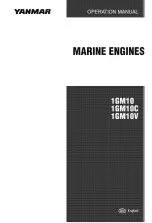
A26
Operation
First time usage
Before starting the engine fill the gearbox with one of the recommended lubricants
to the maximum level
indicated on the dipstick.
Ensure that the gearbox is in neutral, it is recommended that the optional neutral safety start switch (if fitted) should
be wired in
to
the starter circuit to avoid uncontrolled boat movement on starting-up. Start up and run the engine
and gearbox for a few minutes
to allow the oil
to
circulate through the cooling circuit (and angle drive if fitted). Stop
the engine, allow to settle, check the oil level and ‘top-up’ to the maximum level shown on the dipstick.
Operating temperature
Normal operating temperature should be between 50°C
-
with a maximum of 80°C. The oil coolers supplied
for fitting
to
Newage PRM gearboxes have adequate capacity
to
ensure correct operating temperature under all
conditions.
Gear
shifting
Newage PRM marine gearboxes have been designed and tested
to
ensure rapid shifts from ahead and astern and
vice versa can be operated at full horsepower ratings and speeds, and the transmission will respond rapidly in
these circumstances. Full power shifts, however, do place abnormal, even if short lived, loads on the gearbox, and
the operating life will be increased if they are reserved for emergency use only.
Trailing (free-wheeling) the propeller.
The bearings used in Newarge PRM gearboxes have been carefully selected
to ensure that prolonged trailing
(free-wheeling) of the propeller will not have any detrimental effect on the transmission. This allows the propeller
to
turn freely with the engine shut down and makes Newage PRM gearboxes particularly suited for use in
sailboats, motor sailers, or multi-engine installations where the boat may be operated with one or more engines
shut down.
Emergency operation
Included as standard in every Newage PRM marine gearboxes is a ‘Get-You-Home’ device, allowing the gearbox
to be mechanically locked in ‘ahead’ drive, in the unlikely event of hydraulic failure.
ROUTINE MAINTENANCE
After
25
hours running
Drain all oil from the gearbox and refill with one of the recommended lubricants. Operate the engine and gearbox,
allowing the oil
to
circulate, then stop the engine and allow the oil
to
settle. Re-check the oil level and top up if
necessary
to the maximum mark on the dipstick.
Daily
Check oil level and make visual check for oil leaks especially at the output shaft oil seal and at gasket sealing surfaces.
Annually
Check oil cooler hoses and connections
Check propeller shaft alignment
Ensure that remote control operating linkage is adjusted
to give the correct travel on the gearbox operating lever.
TWIN DISC MARINE TRANSMISSION
All moving parts of the transmission are lubricated by the oil within the sump as it travels throughout the hydraulic
system. The oil used should be of the same quality and type recommended for use in the engine. Use
HD
when the inlet water temperature
to
the heat exchanger is above
and
HD when this temperature is
below
Oil level in the transmission should be checked daily with the engine at idle speed and the marine transmission in
“neutral”. Oil level must be maintained at the “full” mark on the dipstick. The period between oil changes is
1000
hours of operation or 6 months, whichever occurs first. At each oil change the filter screen, installed at the bottom
of the rear cover and extending into the sump, should be removed and cleaned.
It
should be re-installed using pipe
sealant or pipe thread compound on the threads. The breather cap should also be removed and flushed in clean
diesel fuel. Next, disconnect the heat exchanger hoses and drain all the oil from the heat exchanger. Finally, if an
oil filter is used in the hydraulic system, drain the filter and connecting hoses, and replace the filter element.
To drain the transmission, remove the Hex-Head plug from the bottom of the main housing. When re-filling, use
1.2 US gallons
(4.456
Its)
of oil. Pour the oil into the breather cap opening. After filling, start the engine and shift
the unit from “forward” to ‘‘reverse” several times
to
fill the oil lube lines, heat exchanger etc. with oil. Set the engine
at idle speed and the transmission in “neutral”. The oil level must be
to
the “full” mark on the dipstick. Re-instal the
breather cap when the correct level has been reached and run the transmission until the oil temperature has been
raised
to
its operating range. Re-check the oil level and top up
if
necessary.
Periodically inspect hoses for signs of leak, damage or sponginess, replacing where necessary. Pressure and
temperature gages should be regularly inspected and replaced
if found to be damaged or of suspect accuracy.
If information on any other transmission is required, please contact Lehman and such information will be forwarded
to you.
Summary of Contents for SP135
Page 1: ......
Page 23: ...c9 I1 SEE OVER ...













































